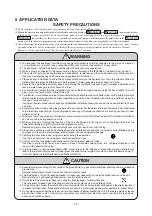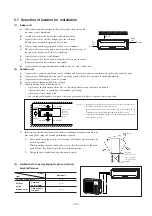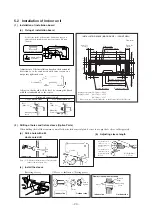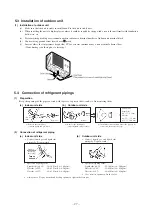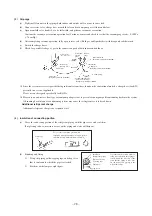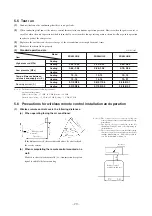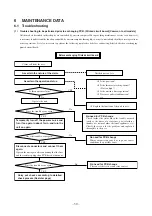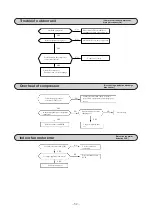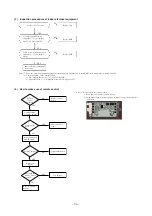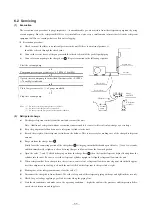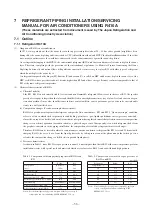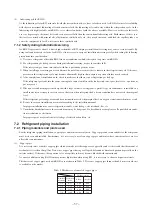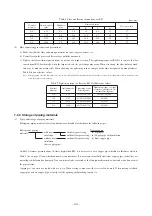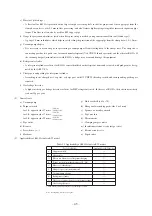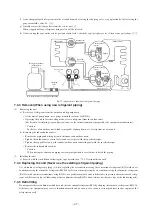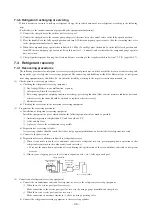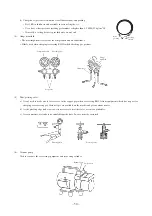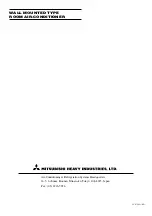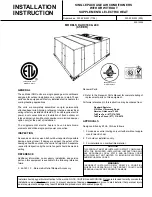
-
36
-
7
REFRIGERANT PIPING INSTALLATION/SERVICING
MANUAL FOR AIR CONDITIONERS USING R410A
(These materials are extracted from document issued by The Japan Refrigeration and
Air Conditioning Industry Association)
7.1 Outline
7.1.1 Refrigerant R410A
(1)
Adoption of R410A in air conditioners
In 1974, it was pointed out that the ozone layer in the upper stratosphere (about 20 ~ 40 km above ground) might have been
damaged by the ozone depleting substances such as CFC (chlorofluorocarbon) and HCFC (hydrochlorofluorocarbon). Since that
time, many countries across the world have endeavored to take countermeasures against the ozone depletion.
As a refrigerant belonging to the HCFCs, the conventional refrigerant (R22) used in air conditioners also tends to deplete the ozone
layer. Therefore, complying with the provisions of the international regulations (i.e. Montreal Protocol concerning the Ozone
Depleting Substances) and national laws & Regulations concerned, it is necessary to replace R22 with other types of refrigerant
which do not deplete the ozone layer.
A refrigerant composed of hydrogen (H), fluorine (F) and carbon (C), is called an HFC and does not deplete the ozone layer. One
HFC’s is R410A whose pressure is about 1.6 times higher than R22 and whose energy efficiency is almost comparable to that of
R22 at the same refrigerant temperature.
(2)
Chemical characteristics of R410A
a) Chemical stability
Like R22, R410A is a chemically stable, less toxic and non-flammable refrigerant. However, as in the case of R22, the specific
gravity of its vapour is larger than that of air and should it leak in an airtight room it may stay at a low level and cause an oxygen
starvation accident. It may also, should it come in direct contact with fire, cause a poisonous gas to occur, so be sure to handle
it only in a well ventilated area.
b) Composition changes (Pseudo-azeotropic characteristics)
R410A is a pseudo-azeotropic mixed refrigerant composed of two constituents - R32 and R125. “Quasi-azeotropic” condition
refers to a state in which the dew-point curve and boiling-point curve - gas-liquid equilibrium curves (pressure constant) -
almost lie on top of each other, and a multi-constituent refrigerant having this chemical characteristic incurs less composition
changes even when evaporation (or condensation) as a phase change occurs. Consequently, even when refrigerant leaks from
the gas phase somewhere in the piping installation, the composition of circulated refrigerant incurs less changes.
Therefore, R410A can be treated in almost a same manner as a mono-constituent refrigerant like R22 is treated. When actually
charging R410A, however, do so from the liquid phase side by taking into account the phenomenon that, when put in a
cylinder, the composition changes a little between gas and liquid phases.
c) Pressure characteristics
As shown in Table 2, since R410A’s vapor pressure is about 1.6 times higher than that of R22 at the same temperature, perform
installation/service with special tools and materials which are exclusive for R410A and can withstand high pressure.
R410A
R22
Composition
R32/R125
R22
(wt%)
(50/50)
(100)
Molecular weight
72.6
86.5
Boiling point (°C)
-51.4
-40.8
Vapor pressure (25°C, MPa)
1.56
0.94
Saturated vapor density (25°C, kg/m
2
)
64.0
44.4
Inflammability
Nonflammable
Nonflammable
Ozone depletion potential (ODP)
0
0.055
Global warming potential (GWP)
1730
1700
Source: List of thermophysical properties complied by the Japan society of
refrigeration and air conditioning, NIST REFPROP V5.10, etc.
Table 1. Comparison of thermophysical properties of R410A and
R22
Refrigerant
R410A
R22
Temperature (°C)
-20
0.30
0.14
0
0.70
0.40
20
1.35
0.81
40
2.32
1.43
60
3.73
2.33
65
4.15
2.60
Source: List of thermophysical properties complied by the Japan
society of refrigeration and air conditioning, NIST
REFPROP V5.10, etc.
Table 2. Comparison of saturated vapor pressure of
R410A and R22
unit: MPa

